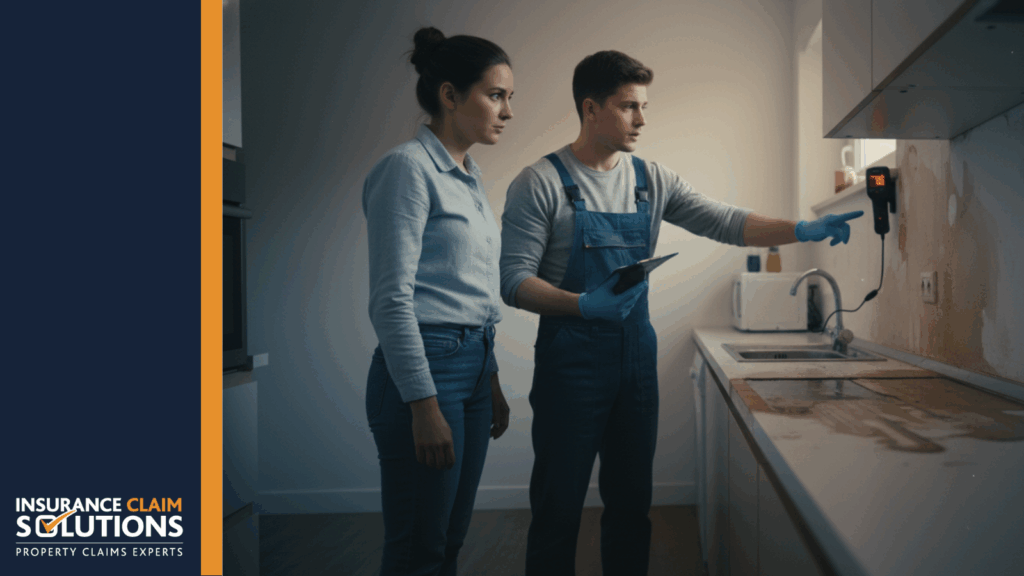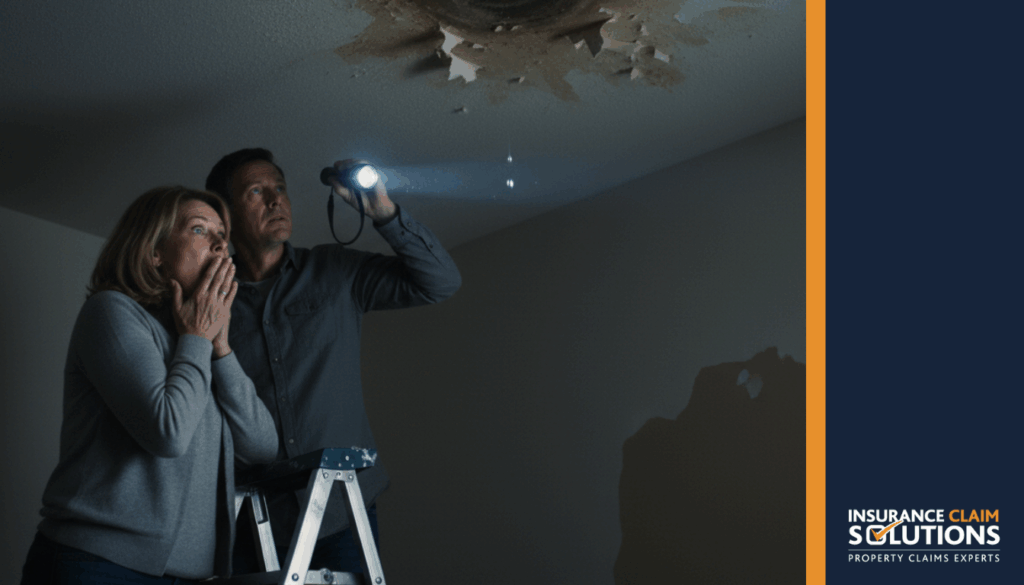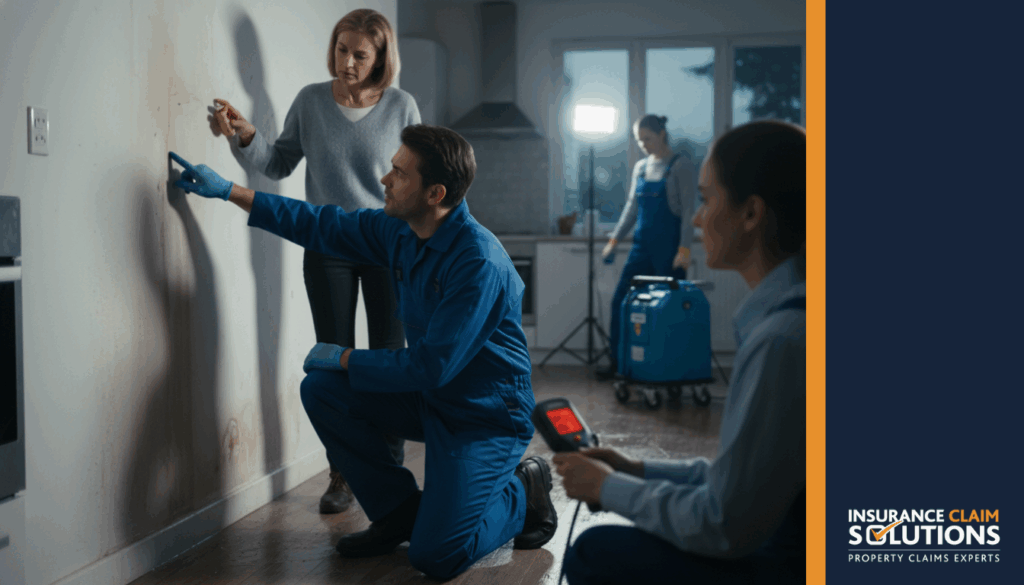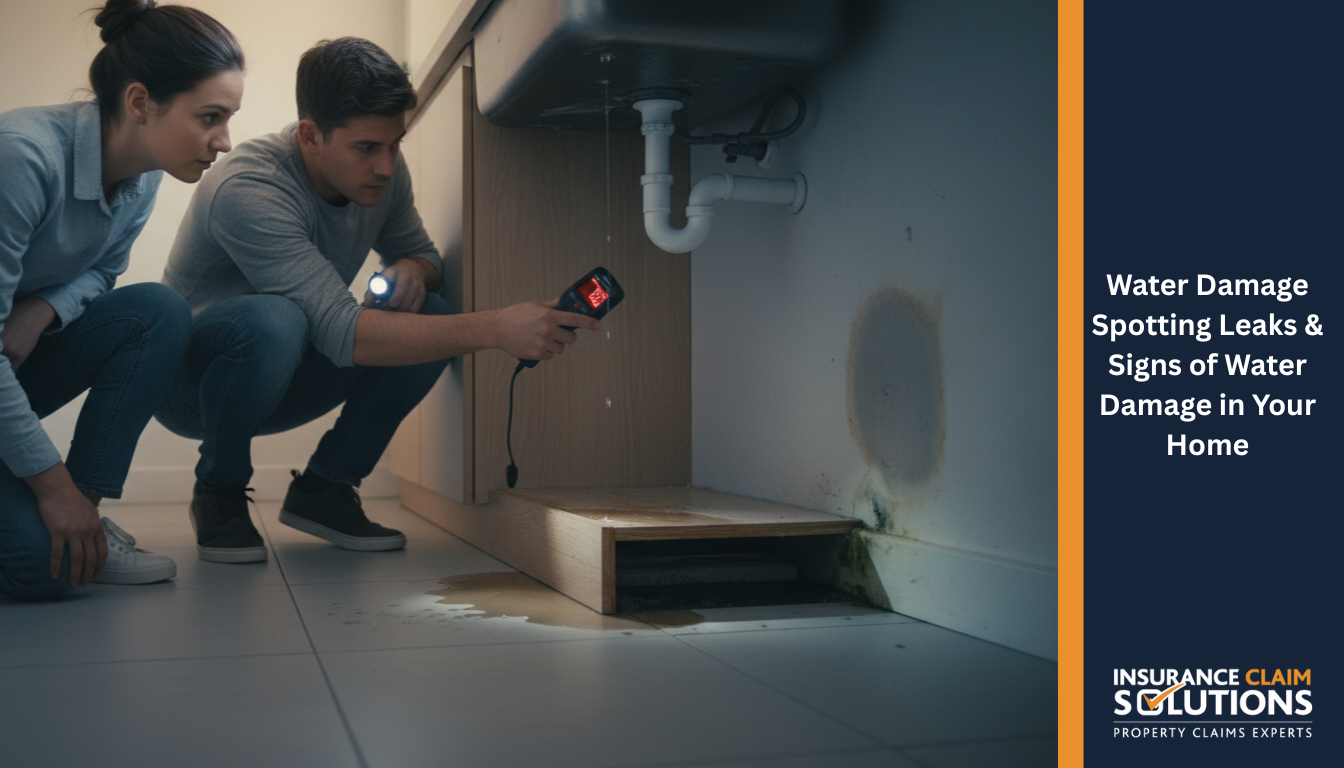Discovering water damage in your home can be a stressful experience. Whether it’s a slow leak you’ve only just noticed or sudden flooding from a burst pipe, water damage requires immediate attention to prevent long-term damage to your property. This guide helps Irish homeowners identify potential leaks, understand the common causes of water damage, and learn what steps to take when water damage occurs. Recognising the signs of water damage early can minimise costly repairs and ensure a smoother insurance claims process.
Understanding Water Damage in Your Home

What is water damage?
Water damage refers to the destructive effects when water intrudes into your property where it shouldn’t be. It can result from various sources, such as a burst pipe in your ceiling, a roof leak after heavy rain, or even a faulty washing machine that floods your kitchen floor. The extent of the damage can range from minor issues like water stains on the ceiling to severe structural damage that creates conditions for mould growth and compromises your home’s integrity.
When it comes to water damage, time matters enormously. Water can cause significant damage surprisingly quickly. Within hours, water begins soaking into floors, walls, and furniture. Within days, mould growth can start, particularly in Ireland’s damp climate. Within weeks, structural damage may develop, and damaged items may become unsalvageable.
Types of water damage
Understanding the type of water involved in your water damage helps determine the appropriate cleanup approach and potential health risks. Water damage restoration specialists categorise water damage based on contamination levels.
Clean water damage originates from sanitary sources like your main water supply. A burst pipe in your water supply system or an overflowing sink with clean water falls into this category. Whilst this water doesn’t pose immediate health risks, it can still cause extensive property damage and create conditions for mould growth if not addressed quickly.
Grey water damage contains some contaminants and might result from appliance leaks, such as water from your washing machine or dishwasher. This water may contain chemicals, soaps, or mild bacteria. Whilst not as dangerous as sewage, it requires more careful cleanup than clean water.
Black water is the most dangerous category, often stemming from flood water, sewage backups, or standing water that’s been untreated for several days. Black water contains harmful bacteria and requires immediate professional water damage cleanup. Never attempt to clean black water yourself.
Common causes of water damage
Several common causes can lead to water damage in Irish homes. Burst pipes are a frequent culprit, particularly during Ireland’s cold snaps when exposed pipes freeze and crack. A burst pipe can release gallons of water quickly, causing extensive damage to your ceiling, walls, and floor.
Roof leaks after heavy rain are common in Ireland’s wet climate. Damaged or missing roof tiles, deteriorated flashing around chimneys, or blocked gutters can all allow water into your ceiling space. Sometimes a leaking roof goes unnoticed for months until water stains appear on your ceiling.
Malfunctioning appliances like washing machines, dishwashers, and water heaters can cause significant water damage if they develop a leak or flood. Hose connections can fail, drain pumps can malfunction, and supply lines can burst, releasing water onto your floor.
External factors, such as flood water during storms, can overwhelm your property. Storm damage combined with inadequate drainage can lead to water entering your home through doors, windows, or even rising through floors.
Identifying Signs of Water Damage

Visible signs of water damage in your home
Spotting the signs of water damage early is crucial for preventing further problems and minimising the extent of the damage. Some indicators are obvious, whilst others require closer inspection of the affected area.
Water stains on your ceiling or walls appear as discolouration, often yellowish or brown patches. These water damage signs indicate water has penetrated your ceiling or wall cavity, possibly from a roof leak above or a burst pipe within the structure. Don’t ignore water stains even if they seem small, as they often indicate larger hidden water damage.
Peeling or bubbling paint and wallpaper suggest moisture behind the surface. When water accumulates between your wall and its covering, it causes these visible water damage signs. The affected area may feel damp to the touch, and you might notice a musty smell, indicating mould growth has already begun.
Buckling floors and damaged components like skirting boards that pull away from walls indicate water has soaked into your floor. Wooden floors are particularly susceptible to water damage, warping and buckling when exposed to moisture.
Mould growth appears as black, green, or white patches and thrives in the damp conditions created by a water leak. Mould growth not only damages your property but also poses health risks. If you notice mould, there’s almost certainly an ongoing moisture problem that needs addressing.
How to detect water damage you can’t see
Not all water damage is immediately visible. Hidden water leaks can cause extensive damage before you notice signs of water damage in your home. Learning to detect water damage early can prevent long-term damage and costly repairs.
Unexplained increases in your water bill often indicate a hidden water leak somewhere in your water supply system. The sound of running water when all taps are shut off suggests a leak somewhere in your pipes. Listen carefully in quiet moments, particularly near your main water supply and bathroom areas.
Musty odours without an obvious source frequently indicate hidden water damage and mould growth in wall cavities, under floors, or in your ceiling space. Don’t mask these smells; instead, investigate to find and stop the water source causing the problem.
Inspecting the affected area
When you suspect water damage, careful inspection of the affected area helps determine the full extent of the damage and identify the source of water. If you see water damage in your ceiling, the leak might originate from the roof, a bathroom above, or a burst pipe in the ceiling space.
Use a torch to check for signs of water damage in dark corners, behind furniture, and in cupboards under sinks. Look for water stains, dampness, mould growth, or damaged items. If you find standing water, shut off the water supply to prevent additional damage while you identify and fix the source of the leak.
Take photographs of all water damage signs and the affected area before beginning any cleanup. This documentation becomes crucial for your water damage insurance claim, providing evidence of the extent of damage for your insurance company.
Water Damage Insurance and Making Claims

Understanding your water damage insurance coverage
Most home insurance policies in Ireland include coverage for water damage, but understanding exactly what’s covered and what’s excluded is essential. Not all water damage qualifies for an insurance claim.
Standard home insurance typically covers sudden and accidental water damage, such as a burst pipe or appliance malfunction. If your washing machine hose suddenly bursts and floods your kitchen floor, your homeowners’ insurance should cover the resulting damage.
However, home insurance policies typically exclude damage from gradual leaks or poor maintenance. If a slow leak from your roof has been dripping for months and you didn’t repair it, your insurer might argue the resulting water damage isn’t covered.
Flood damage from external sources often requires separate flood insurance. If heavy rain overwhelms drainage and flood water enters your home from outside, standard home insurance may not cover this. Properties in flood-risk areas should check their insurance coverage carefully.
Filing a water damage insurance claim
When water damage occurs in your home, filing your insurance claim promptly and correctly helps ensure a smoother claims process. Most insurers require notification within a specific timeframe, so don’t delay.
Document everything thoroughly before beginning cleanup or repairs. Photograph the water damage from multiple angles, showing the affected area, the water source if identifiable, and any damaged items. Contact your insurance company as soon as possible to report the incident.
Take reasonable steps to minimise the damage whilst waiting for your insurer’s response. This might mean using a dehumidifier to start drying the affected area or arranging emergency repairs to stop the water source. Keep receipts for any emergency expenses, as your home insurance may reimburse these costs.
Your insurer will typically send a loss adjuster to inspect the affected area and assess the extent of the damage. They’ll investigate the cause, evaluate what repairs are needed, and determine what’s covered under your insurance policy.
The role of a loss assessor in water damage claims
When dealing with water damage insurance claims, many Irish homeowners find professional representation invaluable. A loss assessor works exclusively for you, not the insurance company, representing your interests throughout the claims process.
Loss assessors understand water damage claims inside out. They know how to assess the full extent of the damage, including hidden problems that might not be immediately obvious. Water damage in your ceiling might indicate problems with pipes, insulation, or structural damage that should be included in your water damage insurance claim.
At Insurance Claim Solutions, we specialise in water damage insurance claims throughout Ireland. Our team takes over the claim process from start to finish, handling damage assessment, documentation, contractor liaison, and insurer negotiation.
Water Damage Restoration and Repair

Steps for effective water damage restoration
The water damage restoration process follows several critical steps to restore your home and prevent long-term damage like mould growth and structural issues.
First, shut off the water supply to stop additional water from entering your home. If a burst pipe caused the damage, turn off your main water valve. Stopping the water source is essential before beginning any water restoration work.
Water extraction removes standing water and excess moisture from your floor, ceiling, and walls. Professional equipment removes water far more effectively than household mops and towels. The faster standing water is removed, the less damage occurs.
Thorough drying and dehumidification follow water extraction. Professional water damage restoration specialists use commercial dehumidifiers and air movers to dry the affected area completely, monitoring moisture levels to ensure thorough drying.
Cleaning and sanitising eliminate contaminants and prevent mould growth. Professional water damage cleanup includes treating affected surfaces with antimicrobial solutions to prevent future problems.
Water damage repair techniques
The type of water damage repair needed depends on the extent of damage and what materials were affected. For minor water stains on your ceiling or walls, spot treatment and repainting may suffice once the source of water has been fixed and the area is completely dry.
Floor damage from water requires careful assessment. Some wooden floors can be dried and sanded if treated quickly, whilst others may need replacement if the water damage is extensive.
Structural damage from water leaks requires professional assessment and repair. If water has compromised beams or joists, qualified contractors must evaluate the damage and implement appropriate repairs to ensure your home remains safe.
Preventing Water Damage in Your Home
Regular inspections for leaks

Prevention is always better than dealing with water damage after it occurs. Regular inspections help you detect water damage in its early stages, when repairs are simpler and less costly.
Inspect around plumbing fixtures regularly, checking under sinks, around toilets, and near your washing machine and dishwasher for any signs of a leak. Look for water stains, dampness, or mould growth.
Check your ceiling for water stains or discolouration, particularly after heavy rain or in rooms below bathrooms. Inspect your roof from outside, looking for damaged or missing tiles that could allow a roof leak to develop. Clear gutters regularly to prevent water from backing up.
Examine exposed pipes, particularly in unheated areas where pipes are more susceptible to freezing. During cold weather, insulate exposed pipes to prevent them from bursting.
Maintaining your property to prevent water damage
Proper maintenance significantly reduces your risk of water damage and helps protect your home from common causes of water damage. Keep your roof in good repair, addressing damaged tiles or flashing promptly. A leaking roof can cause extensive water damage in your ceiling before you notice the problem.
Service appliances regularly, checking hoses and connections on your washing machine, dishwasher, and water heater. Replace ageing rubber hoses with braided stainless steel versions that are less likely to fail.
Maintain adequate ventilation throughout your home to prevent condensation, which can create damp conditions leading to mould growth. This is particularly important in Irish homes, where high humidity and poor ventilation often combine to create moisture problems.
Getting Professional Help

If you’re facing water damage or need help with a water damage insurance claim, professional assistance can make a substantial difference. Insurance Claim Solutions provides expert water damage claim management throughout Ireland.
Our team understands the complexities of water damage claims, from assessing hidden damage to negotiating with insurers. We handle the entire claims process, allowing you to focus on your family. Contact us at 086 053 9137 or email info@insuranceclaimsolutions.ie for a free consultation.
Dealing with water damage? Insurance Claim Solutions provides expert assistance with water damage insurance claims throughout Ireland. Contact us at 086 053 9137 or email info@insuranceclaimsolutions.ie.
Need Help with Your Insurance Claim?
Expert loss assessors working exclusively for you
Contact Insurance Claim Solutions Today!
No Win – No Fee Basis
We work exclusively for you, not the insurance company
Regulated by the Central Bank of Ireland

